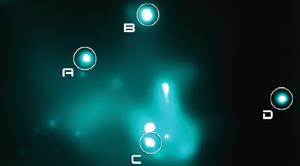A swarm of 10,000 black holes may be orbiting the Milky Way’s supermassive black hole. This estimate is based on theoretical expectations of the migration of black holes in our galaxy and the observation by NASA’s Chandra X-ray Observatory of an over-density of X-ray binaries at the galactic centre.

The centre of our galaxy, the Milky Way, is known to host a black hole called Sagittarius A* (Sgr A*) with a mass of about 3.7 million suns. Around this supermassive black hole there should be a high concentration of stellar-mass black holes, which would have migrated into the galactic centre over several billion years. Stellar-mass black holes form in the core of supernova explosions of stars with masses typically 5-10 times that of the Sun.
When such a massive object flies by one of the greater number of less massive stars, the lighter body gains speed while the heavier body loses speed. Several such two-body interactions make heavier bodies fall towards the galactic centre, while lightweight stars are ejected towards the outer regions of the galaxy. Such a mass segregation is well known in dense globular clusters, and was predicted a decade ago to cause stellar black holes to sink towards the centre of the galaxy. From the estimated number of stars and black holes in the galactic centre region, this effect is expected to produce a dense swarm of 20,000 black holes within three light-years of Sgr A*.
Once black holes are concentrated near Sgr A* they will have many close encounters with normal stars there, some of which are in binary star systems. The intense gravity of a black hole can induce an ordinary star to “change partners” and pair up with the black hole. This process is expected to produce several hundred binary systems with a black hole or a neutron star.
The Chandra X-ray observations of the central region of the galaxy now show evidence of a high concentration of binary systems around Sgr A*. M P Muno, from the University of California, Los Angeles, and colleagues found four active X-ray binary sources at less than three light-years from Sgr A*, while there would be only a 20% chance of finding one such source in this small area. This estimate is based on the density of sources observed at a slightly larger distance from Sgr A*, between 3 and 75 light-years. The derived over-abundance of X-ray binaries by a factor of 20 suggests that a huge number of black holes and/or neutron stars have gathered at the galaxy centre.
Although this study clearly shows an excess of X-ray binaries at the centre of the galaxy, it is difficult to extrapolate from the four sources that are active at a given moment to the total number of black holes orbiting Sgr A*. Many processes are difficult to quantify, in particular the fraction of black holes and neutron stars that are paired with a normal star to form an X-ray binary system, and the rate of activity of these systems. Further theoretical and observational studies will be needed to confirm the presence of a swarm of some 10,000 black holes at the heart of our galaxy.
Further reading
M P Muno et al., submitted to ApJL, http://arxiv.org/abs/astro-ph/0412492.
Author:
Compiled by Marc Türler, INTEGRAL Science Data Centre and Geneva University.








